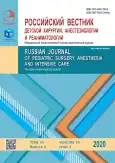Гнойно-некротический парапроктит у ребенка 5 лет: клиническое наблюдение
- Авторы: Степанова Н.М.1,2, Руденко Н.Ю.3, Дюков А.А.3, Ли И.Б.3
-
Учреждения:
- Федеральное государственное бюджетное образовательное учреждение высшего профессионального образования «Иркутский государственный медицинский университет» Министерства здравоохранения Российской Федерации
- Областное государственное автономное учреждение здравоохранения «Городская Ивано-Матренинская детская клиническая больница»
- Государственное бюджетное учреждение здравоохранения «Иркутская областная детская клиническая больница»
- Выпуск: Том 10, № 4 (2020)
- Страницы: 461-466
- Раздел: Клинические случаи
- URL: https://journal-vniispk.ru/2219-4061/article/view/122930
- DOI: https://doi.org/10.17816/psaic685
- ID: 122930
Цитировать
Полный текст
Аннотация
Представлено редкое клиническое наблюдение успешного лечения ребенка 5 лет с гнойно-некротическим парапроктитом, развившимся на фоне первичного иммунодефицитного состояния.
Описание наблюдения. Мальчик, 5 лет, заболел остро, когда на фоне диареи с гипертермией в перианальной области появился участок гиперемии, отека и инфильтрации тканей. В анамнезе: частые респираторные инфекции и дисфункция кишечного тракта в виде диареи. Госпитализирован в Областную детскую больницу на 10-е сутки заболевания из районной больницы, где было начато лечение антибиотиками. При поступлении состояние тяжелое, в перианальной области обширная рана с некротическими тканями и налетом фибрина. Для создания благоприятных условий для заживления раны была проведена операция превентивной сигмостомии. В посеве из раны обнаружена полирезистентная Pseudomonas aeruginosa. Проводилось лечение курсами антибиотиков, инфузионная терапия, выполнена хирургическая обработка раны перианальной области и местное лечение. При обследовании иммунологического статуса выявлено первичное иммунодефицитное состояние, по поводу которого вводились препараты с иммуноглобулином G. В результате проведенного лечения рана зажила вторичным натяжением, проведена операция закрытия сигмостомы. Ребенок выписан в удовлетворительном состоянии под наблюдение иммунолога и хирурга.
Обсуждение. В данном случае оправдано превентивное выполнение сигмостомии, хотя в других наблюдениях авторы ограничивались хирургическим вмешательством на промежности. Pseudomonas aeruginosa проявляет свою патогенность у пациентов с нарушениями иммунитета. Поэтому, наряду с хирургическим лечением, курсами антибиотиков, инфузионной терапией, только при назначении иммуномодулирующей терапии был достигнут благоприятный результат.
Заключение. Детей с гнойно-некротическим парапроктитом, развившимся на фоне первичного иммунодефицитного состояния необходимо как можно раньше госпитализировать в специализированный стационар.
Ключевые слова
Полный текст
Открыть статью на сайте журналаОб авторах
Наталия Маратовна Степанова
Федеральное государственное бюджетное образовательное учреждение высшего профессионального образования «Иркутский государственный медицинский университет» Министерства здравоохранения Российской Федерации; Областное государственное автономное учреждение здравоохранения «Городская Ивано-Матренинская детская клиническая больница»
Автор, ответственный за переписку.
Email: sergiklee@mail.ru
канд. мед. наук, доцент кафедры детской хирургии ФГБОУ ВО ИГМУ, врач-детский хирург ОГАУЗ ГИМДКБ
Россия, Иркутск; ИркутскНаталья Юрьевна Руденко
Государственное бюджетное учреждение здравоохранения «Иркутская областная детская клиническая больница»
Email: rudenko@igodkb.ru
врач аллерголог-иммунолог, заместитель главного врача по лечебной работе
Россия, ИркутскАндрей Анатольевич Дюков
Государственное бюджетное учреждение здравоохранения «Иркутская областная детская клиническая больница»
Email: rudenko@igodkb.ru
канд. мед. наук, врач-детский хирург, заведующий отделением гнойной хирургии
Россия, ИркутскИгорь Беокович Ли
Государственное бюджетное учреждение здравоохранения «Иркутская областная детская клиническая больница»
Email: tokio197@mail.ru
врач-детский хирург
Россия, Иркутск







